What'sNEW July-September 2011
Single-stranded circular DNA viruses have entered eukaryotic genomes many times. Over 300 examples were recently found by biologists working in China and Kentucky. Obviously, the variety of mechanisms for horizontal gene transfer (HGT) into eukaryotes is not limited to retroviruses.
| "We conclude that the replication initiation protein (Rep)-related sequences of geminiviruses, nanoviruses and circoviruses have been frequently transferred to a broad range of eukaryotic species, including plants, fungi, animals and protists. Some of the transferred viral genes were conserved and expressed, suggesting that these genes have been coopted to assume cellular functions in the host genomes. We also identified geminivirus-like and parvovirus-like transposable elements in genomes of fungi and lower animals, respectively, and thereby provide direct evidence that eukaryotic transposons could derive from ssDNA viruses." |
 Huiquan Liu et al., "Widespread Horizontal Gene Transfer from Circular Single-stranded DNA Viruses to Eukaryotic Genomes" [Open Access abstract], doi:10.1186/1471-2148-11-276, v11 n276, BMC Evolutionary Biology, 26 Sep 2011. Huiquan Liu et al., "Widespread Horizontal Gene Transfer from Circular Single-stranded DNA Viruses to Eukaryotic Genomes" [Open Access abstract], doi:10.1186/1471-2148-11-276, v11 n276, BMC Evolutionary Biology, 26 Sep 2011.
 Viruses and Other Gene Transfer Mechanisms is a related local webpage — What'sNEW about HGT Viruses and Other Gene Transfer Mechanisms is a related local webpage — What'sNEW about HGT  | |
More than 1500 genes necessary for the evolution of pregnancy in placental mammals were recruited into service, and a transposable element regulates the expression of many of them, according to a team at Yale University. "We conclude that the transposable element, MER20, contributed to the origin of a novel gene regulatory network dedicated to pregnancy in placental mammals, particularly by recruiting the cAMP signaling pathway into endometrial stromal cells."
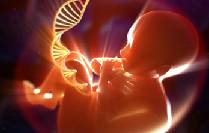 "These transposons are not genes that underwent small changes over long periods of time and eventually grew into their new role during pregnancy. They are more like prefabricated regulatory units that install themselves into a host genome, which then recycles them to carry out entirely new functions like facilitating maternal-fetal communication."
"These transposons are not genes that underwent small changes over long periods of time and eventually grew into their new role during pregnancy. They are more like prefabricated regulatory units that install themselves into a host genome, which then recycles them to carry out entirely new functions like facilitating maternal-fetal communication."
"In the last two decades there have been dramatic changes in our understanding of how evolution works. We used to believe that changes only took place through small mutations in our DNA that accumulated over time. But in this case we found a huge cut-and-paste operation that altered wide areas of the genome to create large-scale morphological change."
1500 unexpressed genes, awaiting recruitment for a major evolutionary advance, defy darwinian logic. But they, and the "cut and paste" method of their deployment and regulation, are confirmations for cosmic ancestry.
| "Our data and those of other recent studies show that transposable elements are potent agents of gene regulatory network evolution and add to an increasing body of evidence indicating that the evolution of novel characters involves genetic mechanisms that are distinct from those involved in the modification of existing characters." |
 Vincent J Lynch et al., "Transposon-mediated rewiring of gene regulatory networks contributed to the evolution of pregnancy in mammals" [abstract], doi:10.1038/ng.917, Nature Genetics, online 25 Sep 2011. Vincent J Lynch et al., "Transposon-mediated rewiring of gene regulatory networks contributed to the evolution of pregnancy in mammals" [abstract], doi:10.1038/ng.917, Nature Genetics, online 25 Sep 2011.
 Invasion of Genomic Parasites Triggered Modern Mammalian Pregnancy, Yale University (also ScienceDaily), 25 Sep 2011. Invasion of Genomic Parasites Triggered Modern Mammalian Pregnancy, Yale University (also ScienceDaily), 25 Sep 2011.
 Viruses and Other Gene Transfer Mechanisms is a related local webpage — What'sNEW about HGT Viruses and Other Gene Transfer Mechanisms is a related local webpage — What'sNEW about HGT  | |
 Metazoan Genes Older Than Metazoa? is a related local webpage with more about genes that exist before they are deployed. Metazoan Genes Older Than Metazoa? is a related local webpage with more about genes that exist before they are deployed.
 New genetic programs in Darwinism and strong panspermia asks whether any genes are composed "through small mutations ...that accumulated over time." New genetic programs in Darwinism and strong panspermia asks whether any genes are composed "through small mutations ...that accumulated over time."
 Thanks, Hans-Peter Wheeler. Thanks, Hans-Peter Wheeler.
 The Buckingham Centre for Astrobiology (BCAB) was affiliated to the University of Buckingham in August 2011. The new centre is a continuation of the pioneering programme of research carried out between 2000 and 2010 at the Cardiff University Centre for Astrobiology (CCAB) under the directorship of Professor Chandra Wickramasinghe.
The Buckingham Centre for Astrobiology (BCAB) was affiliated to the University of Buckingham in August 2011. The new centre is a continuation of the pioneering programme of research carried out between 2000 and 2010 at the Cardiff University Centre for Astrobiology (CCAB) under the directorship of Professor Chandra Wickramasinghe.
 Buckingham Centre for Astrobiology (BCAB) Buckingham Centre for Astrobiology (BCAB)
 Introduction: More Than Panspermia is a related local webpage. Introduction: More Than Panspermia is a related local webpage.
 Chandra Wickramasinghe is a related local webpage. Chandra Wickramasinghe is a related local webpage.
A gene for nervous systems before there were nervous systems on Earth is the subject of study by a European interdisciplinary team. The researchers already knew that primitive single-celled eukaryotes called choanoflagellates carry genes used in the nervous systems of higher animals; now they want to know why a specific one is there. They conclude, "The strict structural and functional conservation of the [studied sequence]... brings now to light that the binary complex must have played an important role in the last common ancestor of choanoflagellates and animals...." What that role might have been is not obvious.

Schematic drawing of the domain structure of a choanoflagellate syntaxin (linked rectangles), and sequence alignments of the N-peptide of syntaxin (left) and of the conserved N-peptide binding site (right) are shown. Choanoflagellate sequences (bottom row) are compared to those (ascending) of sea anemone, nematode, fruitfly, and 3 or 4 mouse alleles. [Figure and caption adapted from Burkhardt et al., 2011]
|
In cosmic ancestry, genes exist before they are deployed. Research under this paradigm would look for examples of them. Here is one. There are lots more.
 Pawel Burkhardt et al., "Primordial neurosecretory apparatus identifed in the choanoflagellate Monosiga brevicollis" [abstract], doi:10.1073/pnas.1106189108, Proc. Natl. Acad. Sci. USA, online 29 Aug 2011. Pawel Burkhardt et al., "Primordial neurosecretory apparatus identifed in the choanoflagellate Monosiga brevicollis" [abstract], doi:10.1073/pnas.1106189108, Proc. Natl. Acad. Sci. USA, online 29 Aug 2011.
 Your brain chemistry existed before animals did by Michael Marshall, NewScientist, 1 Sep 2011. Your brain chemistry existed before animals did by Michael Marshall, NewScientist, 1 Sep 2011.
 Metazoan Genes Older Than Metazoa? is a related local webpage with more examples. Search for "nervous system" for closely related articles. Metazoan Genes Older Than Metazoa? is a related local webpage with more examples. Search for "nervous system" for closely related articles.
CORRECTION: Antibiotic resistance genes predate the USE [not existence] of the antibiotics they counteract. Therefore, the genes may have undergone selective pressure for 30,000 years, contrary to our assertion of two days ago.
 Thanks for your questions, Ken Jopp and Pedro Pereira. Thanks for your questions, Ken Jopp and Pedro Pereira.
Antibiotic resistance genes are much older than modern antibiotics, according to a team who recovered the genes in a layer of uncontaminated mud 20 feet deep near Bear Creek in the Yukon Territory. "The ancient bacteria in the sediments turned out to contain all the major genes that enable modern bacteria to resist antibiotics.... This work firmly establishes that antibiotic resistance genes predate our use of antibiotics."
"Vancomycin resistance took the clinical community by surprise when it emerged in pathogenic enterococci in the late 1980s...." This and other similar developments were initially taken to indicate that antibiotic resistance can evolve very rapidly. Soon it became apparent that resistance genes can spread quickly among bacteria by horizontal gene transfer (HGT). But now it apears that many of the resistance genes predate, by at least 30,000 years, the existence of the antibiotics they counteract.
Genes that exist before there was any selective pressure to program them are a jarring puzzle for darwinism. They are a standard prediction of cosmic ancestry.
 Vanessa M. D'Costa, Christine E. King et al., "Antibiotic resistance is ancient"
[html], doi:10.1038/nature10388, Nature, online 31 Aug 2011. Vanessa M. D'Costa, Christine E. King et al., "Antibiotic resistance is ancient"
[html], doi:10.1038/nature10388, Nature, online 31 Aug 2011.
 Resistance to Antibiotics Is Ancient, McMaster University (also Newswise), 31 Aug 2011. Resistance to Antibiotics Is Ancient, McMaster University (also Newswise), 31 Aug 2011.
 Researchers Find Antibiotic Resistance in Ancient DNA by Nicholas Wade, The New York Times, 31 Aug 2011. Researchers Find Antibiotic Resistance in Ancient DNA by Nicholas Wade, The New York Times, 31 Aug 2011.
...Adaptive introgression of archaic alleles has significantly shaped modern human immune systems, according to an international, multi-disciplinary team. More evidence that human evolutionary advances are installed with acquired genes.
 Laurent Abi-Rached et al., "The Shaping of Modern Human Immune Systems by Multiregional Admixture with Archaic Humans" [abstract], doi:10.1126/science.1209202, Science, online 25 Aug 2011. Laurent Abi-Rached et al., "The Shaping of Modern Human Immune Systems by Multiregional Admixture with Archaic Humans" [abstract], doi:10.1126/science.1209202, Science, online 25 Aug 2011.
 Ann Gibbons, "A Denisovan Legacy in the Immune System?" [summary], doi:10.1126/science.333.6046.1086, p1086 v333, Science, 26 Aug 2011. Ann Gibbons, "A Denisovan Legacy in the Immune System?" [summary], doi:10.1126/science.333.6046.1086, p1086 v333, Science, 26 Aug 2011.
 Testing Darwinism versus Cosmic Ancestry is a related local webpage. Testing Darwinism versus Cosmic Ancestry is a related local webpage.
 Human Genome Search... is a related local webpage. Human Genome Search... is a related local webpage.
 New genetic programs in Darwinism and strong panspermia is a related local webpage. New genetic programs in Darwinism and strong panspermia is a related local webpage.
Panspermia is more likely than we thought. A new analysis reveals that life-bearing particles from Earth may reach Mars or the moons of Jupiter more frequently than estimated previously.
 M. Reyes-Ruiz et al., "Dynamics of escaping Earth ejecta and their collision probability with different Solar System bodies" [abstract], arXiv:1108.3375v1, Earth and Planetary Astrophysics, onlne 17 Aug 2011. M. Reyes-Ruiz et al., "Dynamics of escaping Earth ejecta and their collision probability with different Solar System bodies" [abstract], arXiv:1108.3375v1, Earth and Planetary Astrophysics, onlne 17 Aug 2011.
 Impacts 'more likely' to have spread life from Earth, BBC News, 23 Aug 2011. Impacts 'more likely' to have spread life from Earth, BBC News, 23 Aug 2011.
 Impacts may spread life to other planets by Stuart Gary, ABC Science, 29 Aug 2011. Impacts may spread life to other planets by Stuart Gary, ABC Science, 29 Aug 2011.
 Life from Earth could be spreading across the galaxy by Patrick Foot, Cosmos Online, 31 Aug 2011. Life from Earth could be spreading across the galaxy by Patrick Foot, Cosmos Online, 31 Aug 2011.
 Introduction: More Than Panspermia is a related local webpage. Introduction: More Than Panspermia is a related local webpage.
 Thanks, Anthony Mugan, Stan Franklin, Google Alerts and Bob Sweeney. Thanks, Anthony Mugan, Stan Franklin, Google Alerts and Bob Sweeney.
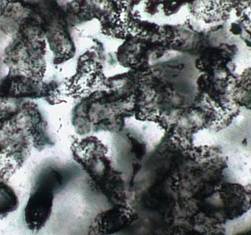 Fossilized microorganisms that are 3.4 billion years old have been found in in Western Australian sandstone. They would be the oldest known fossilized cells on earth, according to palaeobiologist Martin Brasier of the University of Oxford, a member of the team reporting the finding. Even older ones were reported by Bill Schopf of UCLA in 1993, but Brasier thinks those are mineral artifacts. Schopf disagrees, and the dispute has been occasionally rancorous.
Fossilized microorganisms that are 3.4 billion years old have been found in in Western Australian sandstone. They would be the oldest known fossilized cells on earth, according to palaeobiologist Martin Brasier of the University of Oxford, a member of the team reporting the finding. Even older ones were reported by Bill Schopf of UCLA in 1993, but Brasier thinks those are mineral artifacts. Schopf disagrees, and the dispute has been occasionally rancorous.Evidence for even older life on Earth comes from rocks whose isotopic fractionation is best explained by cellular metabolism, so the case for old life is strong. And if life appeared on Earth so promptly after the planet cooled, panspermia looks like a reasonable explanation.
 David Wacey et al., "Microfossils of sulphur-metabolizing cells in 3.4-billion-year-old rocks of Western Australia" [abstract], doi:10.1038/ngeo1238, Nature Geoscience, online 21 Aug 2011. David Wacey et al., "Microfossils of sulphur-metabolizing cells in 3.4-billion-year-old rocks of Western Australia" [abstract], doi:10.1038/ngeo1238, Nature Geoscience, online 21 Aug 2011.
 Lee Sweetlove, "New Oldest Fossils" [html], doi:10.1038/news.2011.491, NatureNews, online 21 Aug 2011. Lee Sweetlove, "New Oldest Fossils" [html], doi:10.1038/news.2011.491, NatureNews, online 21 Aug 2011.
 Nicholas Wade, "Team Claims It Has Found Oldest Fossils" [html], The New York Times, 21 Aug 2011. Nicholas Wade, "Team Claims It Has Found Oldest Fossils" [html], The New York Times, 21 Aug 2011.
 Jef Akst, "New Oldest Fossils" [html], The Scientist, 22 Aug 2011. Jef Akst, "New Oldest Fossils" [html], The Scientist, 22 Aug 2011.
 World's Oldest Fossils Found in Ancient Australian Beach Elizabeth Pennisi, ScienceNow, 21 Aug 2011. World's Oldest Fossils Found in Ancient Australian Beach Elizabeth Pennisi, ScienceNow, 21 Aug 2011.
 Life Before 3850 Million Years Ago? is a related local webpage. Life Before 3850 Million Years Ago? is a related local webpage.
 Thanks, Genevieve Christy and Stan Franklin. Thanks, Genevieve Christy and Stan Franklin.
Water flowing on Mars today, not eons ago, is reported by a team led by planetary scientist Alfred McEwen at the University of Arizona. Images from NASA's Mars Reconnaissance Orbiter show dark streaks that grow downhill hundreds of meters in summer and then fade when winter comes. "Where there is liquid water... there could be life," Richard Kerr comments.
 Alfred S. McEwen et al., "Seasonal Flows on Warm Martian Slopes" [summary], doi:10.1126/science.1204816, p740-743 v333, Science, 5 Aug 2011. Alfred S. McEwen et al., "Seasonal Flows on Warm Martian Slopes" [summary], doi:10.1126/science.1204816, p740-743 v333, Science, 5 Aug 2011.
 Is Mars Weeping Salty Tears? (with images) by Richard A. Kerr, ScienceNow, 4 Aug 2011. Is Mars Weeping Salty Tears? (with images) by Richard A. Kerr, ScienceNow, 4 Aug 2011.
 Microbial life on Mars: Could saltwater make it possible?, University of Michigan, 16 Aug 2011. Microbial life on Mars: Could saltwater make it possible?, University of Michigan, 16 Aug 2011.
 Life on Mars! is a local webpage with more about evidence for water and life there. Life on Mars! is a local webpage with more about evidence for water and life there.
DNA in space is announced by a team at the Carnegie Institution of Washington. More precisely, the team found a diverse suite of nucleobases, especially in two of 12 mostly carbonaceous meteorites analysed by liquid chromatography-mass spectrometry. Because some of the nucleobases are terrestrially rare, they are unlikely to be contaminants. In parallel experiments, the scientists "found an identical suite of nucleobases and nucleobase analogs generated in reactions of ammonium cyanide." Therefore they conclude that chemistry in space can provide some of life's nucleobases.
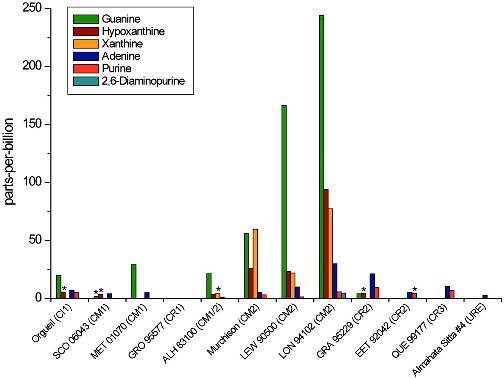 This work provides good support for "pseudo-panspermia," the theory that space provides the starter ingredients for a prebiotic soup. Of course, we think that organic compounds in space may well be postbiotic. Consequently, we wonder if a suite of organics remaining from dead cells, after millions of years in space, might also resemble the meteorites' contents. Nonetheless, we welcome this support for a version of panspermia.
This work provides good support for "pseudo-panspermia," the theory that space provides the starter ingredients for a prebiotic soup. Of course, we think that organic compounds in space may well be postbiotic. Consequently, we wonder if a suite of organics remaining from dead cells, after millions of years in space, might also resemble the meteorites' contents. Nonetheless, we welcome this support for a version of panspermia.
 Michael P. Callahan et al., "Carbonaceous meteorites contain a wide range of extraterrestrial nucleobases" [Open Access abstract], doi:10.1073/pnas.1106493108, Proc. Natl. Acad. Sci. USA, online 11 Aug 2011. Michael P. Callahan et al., "Carbonaceous meteorites contain a wide range of extraterrestrial nucleobases" [Open Access abstract], doi:10.1073/pnas.1106493108, Proc. Natl. Acad. Sci. USA, online 11 Aug 2011.
 Meteorites: Tool kits for creating life on Earth, Carnegie Institution of Washington, 8 Aug 2011. Meteorites: Tool kits for creating life on Earth, Carnegie Institution of Washington, 8 Aug 2011.
 Evidence Found for Space-Created DNA Building Blocks, 3-minute video from Space.com, c. 8 Aug 2011. Evidence Found for Space-Created DNA Building Blocks, 3-minute video from Space.com, c. 8 Aug 2011.
 NASA Researchers: DNA Building Blocks Can Be Made in Space, by Bill Steigerwald, NASA's Goddard Space Flight Center, 8 Aug 2011. NASA Researchers: DNA Building Blocks Can Be Made in Space, by Bill Steigerwald, NASA's Goddard Space Flight Center, 8 Aug 2011.
 Building Blocks of DNA Found in Meteorites From Space, by Charles Q. Choi, Fox News, 9 Aug 2011. Building Blocks of DNA Found in Meteorites From Space, by Charles Q. Choi, Fox News, 9 Aug 2011.
 DNA in Space? Biological Building Blocks Found in Meteorites by Michael D. Lemonick, Time, 11 Aug 2011 DNA in Space? Biological Building Blocks Found in Meteorites by Michael D. Lemonick, Time, 11 Aug 2011
 DNA components found in meteorites, CNN.com, 11 Aug 2011 DNA components found in meteorites, CNN.com, 11 Aug 2011
 In Case You Missed It -- NASA Finds Traces of DNA in Space, New America Media, 12 Aug 2011. In Case You Missed It -- NASA Finds Traces of DNA in Space, New America Media, 12 Aug 2011.
 Panspermia Asks New Questions is a related local webpage with more about pseudo-panspermia. Panspermia Asks New Questions is a related local webpage with more about pseudo-panspermia.
 Thanks, Stan Franklin, Samuel McIntyre, Marty Langford, Google Alerts, Ken Jopp, Billy Riley, Thomas Ray, Mike Peabody, Walter Klyce and others. Thanks, Stan Franklin, Samuel McIntyre, Marty Langford, Google Alerts, Ken Jopp, Billy Riley, Thomas Ray, Mike Peabody, Walter Klyce and others.
Our findings demonstrate that ancestral genes can control the ability of horizontally acquired genes to confer species-specific traits upon different organisms.
 Chen HD, Jewett MW, Groisman EA, "Ancestral Genes Can Control the Ability of Horizontally Acquired Loci to Confer New Traits" [html], doi:10.1371/journal.pgen.1002184, e1002184, 7(7), PLoS Genet, online 21 July 2011. Chen HD, Jewett MW, Groisman EA, "Ancestral Genes Can Control the Ability of Horizontally Acquired Loci to Confer New Traits" [html], doi:10.1371/journal.pgen.1002184, e1002184, 7(7), PLoS Genet, online 21 July 2011.
 Viruses and Other Gene Transfer Mechanisms is a related local webpage — What'sNEW about HGT Viruses and Other Gene Transfer Mechanisms is a related local webpage — What'sNEW about HGT  | |
NASA's Astrobiology Program will sponsor AbSciCon 2012 in Atlanta GA, April 16-20, 2012. This year's cochairs are Loren Williams and Eric Gaucher of Georgia Institute of Technology. Detailed meeting information will be posted on the website September 1st.
 AbSciCon 2012, "Exploring Life: Past and Present, Near and Far," Atlanta GA, 16-20 Apr 2012. AbSciCon 2012, "Exploring Life: Past and Present, Near and Far," Atlanta GA, 16-20 Apr 2012.
 Thanks, Vera Kolb. Thanks, Vera Kolb.
Transposable Elements (TEs) appear to have installed genetic programs implicated in 99 different primate-specific traits, according to a new article by a pair of biologists at Murdoch University in Perth, Australia. They classify the traits into four broad categories (see figure).
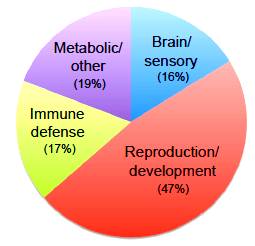 Oliver and Greene write: "TEs can act to generate genetic novelties and thus specific phenotypic traits in numerous ways. Besides passively promoting exon, gene or segmental duplications (or deletions) by unequal recombination, or by disruption of genes via insertion, TEs can actively contribute to gene structure or regulation via exaptation. On multiple occasions, TEs have been domesticated to provide the raw material for entire genes or novel gene fusions. More frequently, TEs have contributed partially to individual genes through exonization after acquisition of splice sites. Independent exons generated by TEs are often alternatively spliced, and thereby result in novel expressed isoforms that increase the size of the transcriptome."
Oliver and Greene write: "TEs can act to generate genetic novelties and thus specific phenotypic traits in numerous ways. Besides passively promoting exon, gene or segmental duplications (or deletions) by unequal recombination, or by disruption of genes via insertion, TEs can actively contribute to gene structure or regulation via exaptation. On multiple occasions, TEs have been domesticated to provide the raw material for entire genes or novel gene fusions. More frequently, TEs have contributed partially to individual genes through exonization after acquisition of splice sites. Independent exons generated by TEs are often alternatively spliced, and thereby result in novel expressed isoforms that increase the size of the transcriptome."
"The generation of novel gene sequences during evolution seems to be heavily outweighed by genetic or epigenetic changes in the transcriptional regulation of pre-existing genes. Consistent with this, much evidence indicates that a major way in which TEs have acted to functionally modify primate genomes is by actively inserting novel regulatory elements adjacent to genes, thus silencing or enhancing expression levels or changing expression patterns, often in a tissue-specific manner."
"A role for TEs in evolution has long been recognized by many, yet its importance has probably been underestimated. Using primates as exemplar lineages, we have assessed specific evidence, and conclude that it points strongly to an instrumental role for TEs... in engineering the divergence of the simian lineage from other mammalian lineages. TEs, particularly Alu SINEs, have essentially acted as a huge primate-restricted stockpile of potential exons and regulatory regions, and thereby have provided the raw material for these evolutionary transitions."
In a 2009 article titled, "Transposable elements: powerful facilitators of evolution", the same biologists observe:
|
Oliver and Greene also classify the TEs implicated above into four categories, one of which includes endogenous retroviruses. This inclusion only adds to the growing recognition of the association between TEs and viruses. We now suspect that our original focus on viruses, strictly defined, as agents of horizontal gene transfer may have been too narrow. |
- Transposable elements... can cause genetic changes of great magnitude and variety.
- TEs are ubiquitous and extremely ancient....
- ...Although harmful to some individuals, they can be very beneficial to lineages.
- TEs can build, sculpt, and reformat genomes by both active and passive means
- TEs have ancient origins that are traceable to prokaryotes.
- TEs often comprise a large, if not massive, fraction of the eukaryotic genome.
- Periodic infestations of genomes by novel TEs predict 'punctuated equilibrium'....
- Many TE families are conspicuously lineage-specific....
- ...TEs [have] the potential to explain why certain other animal clades are anomalously large....
- TEs [may be] a prerequisite for evolutionary radiation
- TE activity increases under conditions of stress.
- TEs are differentially active in the germ line and during early embryogenesis
- ...Given their ancient origins, the biological and evolutionary impact of TEs is probably still underestimated, since much of their influence may now be untraced, and untraceable.
We have long believed that evolutionary progress depends on genetic programs acquired by HGT in a biologically open system. Beginning in 2001, we sponsored research at the University of Oklahoma to explore this hypothesis by seeking the sources of uniquely human gene families. We think the work from Murdoch University, including the 99 primate-specific traits, supports our hypothesis.
Another recent article, by University of Rochester biologist John H. Werren, asks if TEs and other selfish genetic elements (SGEs) persist "because of their ability to replicate within genomes" or "because they promote the ability of populations to adapt and evolve." He favors the former, but either assumption is consistent with darwinism. Of course, the darwinian framework needs to include an account of the "origin" of these elements, but the account seems to us very sketchy and elusive. We note that the origins of SGEs are not actually observed. Instead, TEs, for example, look "extremely ancient." Under cosmic ancestry they would have to be, to participate in the earthly development of preexisting cosmic life.
 Keith R Oliver and Wayne K Greene, "Mobile DNA and the TE-Thrust hypothesis: supporting evidence from the primates" [html], doi:10.1186/1759-8753-2-8, v2 n8, Mobile DNA, online 31 May 2011. Keith R Oliver and Wayne K Greene, "Mobile DNA and the TE-Thrust hypothesis: supporting evidence from the primates" [html], doi:10.1186/1759-8753-2-8, v2 n8, Mobile DNA, online 31 May 2011.
 Keith R Oliver and Wayne K Greene, "Transposable elements: powerful facilitators of evolution" [PubMed abstract], doi:10.1002/bies.200800219, p703-714 v31, BioEssays, Jul 2009. Keith R Oliver and Wayne K Greene, "Transposable elements: powerful facilitators of evolution" [PubMed abstract], doi:10.1002/bies.200800219, p703-714 v31, BioEssays, Jul 2009.
 Scientists present evidence for groundbreaking evolution theory, Murdoch University, 13 Jul 2011. "...Jumping genes are actually driving the evolutionary process in some species." Scientists present evidence for groundbreaking evolution theory, Murdoch University, 13 Jul 2011. "...Jumping genes are actually driving the evolutionary process in some species."
 John H. Werren, "Selfish genetic elements, genetic conflict, and evolutionary innovation" [abstract], doi:10.1073/pnas.1102343108, p10863-10870 v108, Proc. Natl. Acad. Sci. USA, 28 Jun 2011. John H. Werren, "Selfish genetic elements, genetic conflict, and evolutionary innovation" [abstract], doi:10.1073/pnas.1102343108, p10863-10870 v108, Proc. Natl. Acad. Sci. USA, 28 Jun 2011.
 Viruses and Other Gene Transfer Mechanisms is a related local webpage — What'sNEW about HGT Viruses and Other Gene Transfer Mechanisms is a related local webpage — What'sNEW about HGT  | |
 Human Genome Search at the University of Oklahoma is a local webpage outlining the sponsored research project. Human Genome Search at the University of Oklahoma is a local webpage outlining the sponsored research project.
 Metazoan Genes Older Than Metazoa? is our local webpage about very ancient genetic programs. Metazoan Genes Older Than Metazoa? is our local webpage about very ancient genetic programs.
 Thanks for the University of Murdoch story, Stan Franklin and and Bob Sweeney. Thanks for the University of Murdoch story, Stan Franklin and and Bob Sweeney.
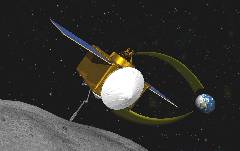 A NASA mission to retrieve a surface sample from an asteroid is scheduled for launch in 2016. OSIRIS-REx will take four years to reach the near-Earth asteroid named 1999 RQ36 in 2020. From three miles away, the probe will inspect the asteroid and then gradually descend to a site chosen for sampling. If all goes well, the mission will return a few ounces of material to a landing in Utah in 2023. The asteroid may be rich in organic compounds relevant to life. University of Arizona astronomer Michael Drake is the principal investigator for the mission.
A NASA mission to retrieve a surface sample from an asteroid is scheduled for launch in 2016. OSIRIS-REx will take four years to reach the near-Earth asteroid named 1999 RQ36 in 2020. From three miles away, the probe will inspect the asteroid and then gradually descend to a site chosen for sampling. If all goes well, the mission will return a few ounces of material to a landing in Utah in 2023. The asteroid may be rich in organic compounds relevant to life. University of Arizona astronomer Michael Drake is the principal investigator for the mission.
 NASA to Launch New Science Mission to Asteroid in 2016, NASA, 25 May 2011. NASA to Launch New Science Mission to Asteroid in 2016, NASA, 25 May 2011.
 UT scientist helps NASA mission that could determine building blocks of life, PhysOrg.com, 18 Jul 2011. UT scientist helps NASA mission that could determine building blocks of life, PhysOrg.com, 18 Jul 2011.
 Comet Rendezvous is a related section of the webpage, "Can The Theory Be Tested?" Comet Rendezvous is a related section of the webpage, "Can The Theory Be Tested?"
 Thanks, Stan Franklin. Thanks, Stan Franklin.
A new video about panspermia includes a range of topics like planet formation, the Oort cloud, organics in space, extremophiles, Lake Vostok, bacteria revived after millions of years, and probable past life on Mars. Paul Davies and Don Brownlee are among the interviewees, and the narrator mentions work by Richard Hoover and Francis Crick. All in less than 13 minutes.

 Panspermia, c. 13-minute video from KPBS, San Diego, posted on YouTube, 13 Jul 2011. Panspermia, c. 13-minute video from KPBS, San Diego, posted on YouTube, 13 Jul 2011.
 Thanks, Google Alerts. Thanks, Google Alerts.
 Introduction: More Than Panspermia is a related local webpage. Introduction: More Than Panspermia is a related local webpage.

 Genetic instructions for developing limbs and digits were present in primitive fish millions of years before their descendants first crawled on to land.... Genetic instructions for developing limbs and digits were present in primitive fish millions of years before their descendants first crawled on to land....
 The genetic switches that drive the expression of genes in the digits of mice are not only present in fish, but the fish sequence can actually activate the expression in mice. The genetic switches that drive the expression of genes in the digits of mice are not only present in fish, but the fish sequence can actually activate the expression in mice.
 ...The new experiments suggest that the genetic switch controlling limb development was in fact present deep in Earth's evolutionary tree. ...The new experiments suggest that the genetic switch controlling limb development was in fact present deep in Earth's evolutionary tree.
 There previously was the idea that these switches had to be generated from scratch de novo, but no, they already existed, they were already there. There previously was the idea that these switches had to be generated from scratch de novo, but no, they already existed, they were already there.
 There is a whole universe of questions that are opened up by this discovery. There is a whole universe of questions that are opened up by this discovery.
These comments come from a team at the University of Chicago Medical Center who compared similar genetic regions in humans, mice, chickens, frogs, and two fish species. They found that the genes that regulate the development of limbs and digits existed before the appearance of limbs and digits. Members of the same research team have studied this issue for years; the conclusion is well supported.
It is said that when J.B.S. Haldane was asked what evidence could destroy his confidence in the theory of evolution, he answered, "fossil rabbits in the Precambrian." They would be out of order in the darwinian narrative. We think the same logic should apply to genes appearing out of order, because there was no opportunity for darwinian trial-and-error to program them. (That existing programs also, luckily, happen to precisely perform new functions is a weak, implausible, ad hoc proposal.) But in cosmic ancestry, genetic programs always exist before the functions they encode.
This example is only one on a fast-growing list of genes older than they should be. They should be as troubling to darwinism as fossil rabbits in the precambrian. If they aren't, perhaps Karl Popper was correct to suggest that the darwinian theory of evolution is impervious to evidence.
 Before animals first walked on land, fish carried gene program for limbs, University of Chicago Medical Center (also EurekAlert and Newswise), 11 Jul 2011. Before animals first walked on land, fish carried gene program for limbs, University of Chicago Medical Center (also EurekAlert and Newswise), 11 Jul 2011.
 Igor Schneider et al., "Appendage expression driven by the Hoxd global control region is an ancient gnathostome feature" [Open Access abstract], doi:10.1073/pnas.1109993108, p12782-12786 v108, Proc. Natl. Acad. Sci. USA, online 15 Jul 2011. Igor Schneider et al., "Appendage expression driven by the Hoxd global control region is an ancient gnathostome feature" [Open Access abstract], doi:10.1073/pnas.1109993108, p12782-12786 v108, Proc. Natl. Acad. Sci. USA, online 15 Jul 2011.
 The genetic and developmental toolkit that builds limbs with fingers and toes was around long before the acquisition of limbs — about earlier work from members of the same group, What'sNEW, 24 May 2007. The genetic and developmental toolkit that builds limbs with fingers and toes was around long before the acquisition of limbs — about earlier work from members of the same group, What'sNEW, 24 May 2007.
 Metazoan Genes Older Than Metazoa? is our main webpage about genes older than the features they encode, with a fast-growing list under What'sNEW there. Metazoan Genes Older Than Metazoa? is our main webpage about genes older than the features they encode, with a fast-growing list under What'sNEW there.
 Genes Older Than Earth? is a possibly related local webpage. Genes Older Than Earth? is a possibly related local webpage.
 Thanks, belatedly, Stan Franklin. Thanks, belatedly, Stan Franklin.
The Joint Conference of ISSOL and Bioastronomy was held in Monpellier, France, July 3-8. Videos of the main presentations are online.

 ISSOL – The International Astrobiology Society and Bioastronomy (IAU C51) Joint International Conference, 3-8 Jul 2011. ISSOL – The International Astrobiology Society and Bioastronomy (IAU C51) Joint International Conference, 3-8 Jul 2011.
 Origins 2011 — conference videos. Origins 2011 — conference videos.
 Thanks, Max Wallis, who answers a negative article about panspermia (New Scientist, 7 May), with "Last century astrobiology from 'instant expert' Caleb Sharf," on Crisis-In-Physics, 7 Jun 2011. Thanks, Max Wallis, who answers a negative article about panspermia (New Scientist, 7 May), with "Last century astrobiology from 'instant expert' Caleb Sharf," on Crisis-In-Physics, 7 Jun 2011.
A 10-minute video about viruses and evolution explains how viruses become integrated into the genomes of their hosts, including humans.

 Human Evolution: Are We Descended From Viruses?, video by Jeremy Mohn posted on YouTube by BestOfScience, 26 Nov 2009. Human Evolution: Are We Descended From Viruses?, video by Jeremy Mohn posted on YouTube by BestOfScience, 26 Nov 2009.
 Thanks, Ronnie McGhee. Thanks, Ronnie McGhee.
 Viruses and Other Gene Transfer Mechanisms is a related local webpage — What'sNEW about HGT Viruses and Other Gene Transfer Mechanisms is a related local webpage — What'sNEW about HGT  | |
 A chemist has announced an Origin-Of-Life prize of 50,000 dollars, to be awarded "for the best original proposal pertaining to the study of the origin of life on Earth...." Harry Lonsdale (pictured), of Bend Oregon, hopes the solution will prove that life can be explained without the need for divine intervention. He believes, "In time, the world will learn that the laws of chemistry and physics, and the principle of evolution by natural selection, are sufficient to explain life's origin."
A chemist has announced an Origin-Of-Life prize of 50,000 dollars, to be awarded "for the best original proposal pertaining to the study of the origin of life on Earth...." Harry Lonsdale (pictured), of Bend Oregon, hopes the solution will prove that life can be explained without the need for divine intervention. He believes, "In time, the world will learn that the laws of chemistry and physics, and the principle of evolution by natural selection, are sufficient to explain life's origin."
Like Harry, our allegiance goes to science. Unlike him, we are not sure that life can originate from nonlife. The evidence so far is not encouraging. But if life cannot originate from nonlife, we will not abandon science. Yet that's the choice that must be made, according to almost everyone. How did that idea originate?
 Origin of Life Research Award Origin of Life Research Award
 Scientist-Politician-Atheist Offers Own Money For Origin of Life Prize by Yudhijit Bhattacharjee, ScienceInsider, 27 Jun 2011. Scientist-Politician-Atheist Offers Own Money For Origin of Life Prize by Yudhijit Bhattacharjee, ScienceInsider, 27 Jun 2011.
 Origin of Life Research Award, AstrobiologyWeb, 30 Aug 2011. Origin of Life Research Award, AstrobiologyWeb, 30 Aug 2011.
 The RNA World... is our main webpage about origin-of-life theories. The RNA World... is our main webpage about origin-of-life theories.
 Evolution versus Creationism is a related local webpage. Evolution versus Creationism is a related local webpage.
|
 The Buckingham Centre for Astrobiology (BCAB) was affiliated to the University of Buckingham in August 2011. The new centre is a continuation of the pioneering programme of research carried out between 2000 and 2010 at the Cardiff University Centre for Astrobiology (CCAB) under the directorship of Professor Chandra Wickramasinghe.
The Buckingham Centre for Astrobiology (BCAB) was affiliated to the University of Buckingham in August 2011. The new centre is a continuation of the pioneering programme of research carried out between 2000 and 2010 at the Cardiff University Centre for Astrobiology (CCAB) under the directorship of Professor Chandra Wickramasinghe. Fossilized microorganisms that are 3.4 billion years old have been found in in Western Australian sandstone. They would be the oldest known fossilized cells on earth, according to palaeobiologist Martin Brasier of the University of Oxford, a member of the team reporting the finding. Even older ones were reported by Bill Schopf of UCLA in 1993, but Brasier thinks those are mineral artifacts. Schopf disagrees, and the dispute has been occasionally rancorous.
Fossilized microorganisms that are 3.4 billion years old have been found in in Western Australian sandstone. They would be the oldest known fossilized cells on earth, according to palaeobiologist Martin Brasier of the University of Oxford, a member of the team reporting the finding. Even older ones were reported by Bill Schopf of UCLA in 1993, but Brasier thinks those are mineral artifacts. Schopf disagrees, and the dispute has been occasionally rancorous. A NASA mission to retrieve a surface sample from an asteroid is scheduled for launch in 2016. OSIRIS-REx will take four years to reach the near-Earth asteroid named 1999 RQ36 in 2020. From three miles away, the probe will inspect the asteroid and then gradually descend to a site chosen for sampling. If all goes well, the mission will return a few ounces of material to a landing in Utah in 2023. The asteroid may be rich in organic compounds relevant to life. University of Arizona astronomer Michael Drake is the principal investigator for the mission.
A NASA mission to retrieve a surface sample from an asteroid is scheduled for launch in 2016. OSIRIS-REx will take four years to reach the near-Earth asteroid named 1999 RQ36 in 2020. From three miles away, the probe will inspect the asteroid and then gradually descend to a site chosen for sampling. If all goes well, the mission will return a few ounces of material to a landing in Utah in 2023. The asteroid may be rich in organic compounds relevant to life. University of Arizona astronomer Michael Drake is the principal investigator for the mission.

 A chemist has announced an Origin-Of-Life prize of 50,000 dollars, to be awarded "for the best original proposal pertaining to the study of the origin of life on Earth...." Harry Lonsdale (pictured), of Bend Oregon, hopes the solution will prove that life can be explained without the need for divine intervention. He believes, "In time, the world will learn that the laws of chemistry and physics, and the principle of evolution by natural selection, are sufficient to explain life's origin."
A chemist has announced an Origin-Of-Life prize of 50,000 dollars, to be awarded "for the best original proposal pertaining to the study of the origin of life on Earth...." Harry Lonsdale (pictured), of Bend Oregon, hopes the solution will prove that life can be explained without the need for divine intervention. He believes, "In time, the world will learn that the laws of chemistry and physics, and the principle of evolution by natural selection, are sufficient to explain life's origin."
 "These transposons are not genes that underwent small changes over long periods of time and eventually grew into their new role during pregnancy. They are more like prefabricated regulatory units that install themselves into a host genome, which then recycles them to carry out entirely new functions like facilitating maternal-fetal communication."
"These transposons are not genes that underwent small changes over long periods of time and eventually grew into their new role during pregnancy. They are more like prefabricated regulatory units that install themselves into a host genome, which then recycles them to carry out entirely new functions like facilitating maternal-fetal communication."

 This work provides good support for "pseudo-panspermia," the theory that space provides the starter ingredients for a prebiotic soup. Of course, we think that organic compounds in space may well be postbiotic. Consequently, we wonder if a suite of organics remaining from dead cells, after millions of years in space, might also resemble the meteorites' contents. Nonetheless, we welcome this support for a version of panspermia.
This work provides good support for "pseudo-panspermia," the theory that space provides the starter ingredients for a prebiotic soup. Of course, we think that organic compounds in space may well be postbiotic. Consequently, we wonder if a suite of organics remaining from dead cells, after millions of years in space, might also resemble the meteorites' contents. Nonetheless, we welcome this support for a version of panspermia.
 Oliver and Greene write: "TEs can act to generate genetic novelties and thus specific phenotypic traits in numerous ways. Besides passively promoting exon, gene or segmental duplications (or deletions) by unequal recombination, or by disruption of genes via insertion, TEs can actively contribute to gene structure or regulation via exaptation. On multiple occasions, TEs have been domesticated to provide the raw material for entire genes or novel gene fusions. More frequently, TEs have contributed partially to individual genes through exonization after acquisition of splice sites. Independent exons generated by TEs are often alternatively spliced, and thereby result in novel expressed isoforms that increase the size of the transcriptome."
Oliver and Greene write: "TEs can act to generate genetic novelties and thus specific phenotypic traits in numerous ways. Besides passively promoting exon, gene or segmental duplications (or deletions) by unequal recombination, or by disruption of genes via insertion, TEs can actively contribute to gene structure or regulation via exaptation. On multiple occasions, TEs have been domesticated to provide the raw material for entire genes or novel gene fusions. More frequently, TEs have contributed partially to individual genes through exonization after acquisition of splice sites. Independent exons generated by TEs are often alternatively spliced, and thereby result in novel expressed isoforms that increase the size of the transcriptome."